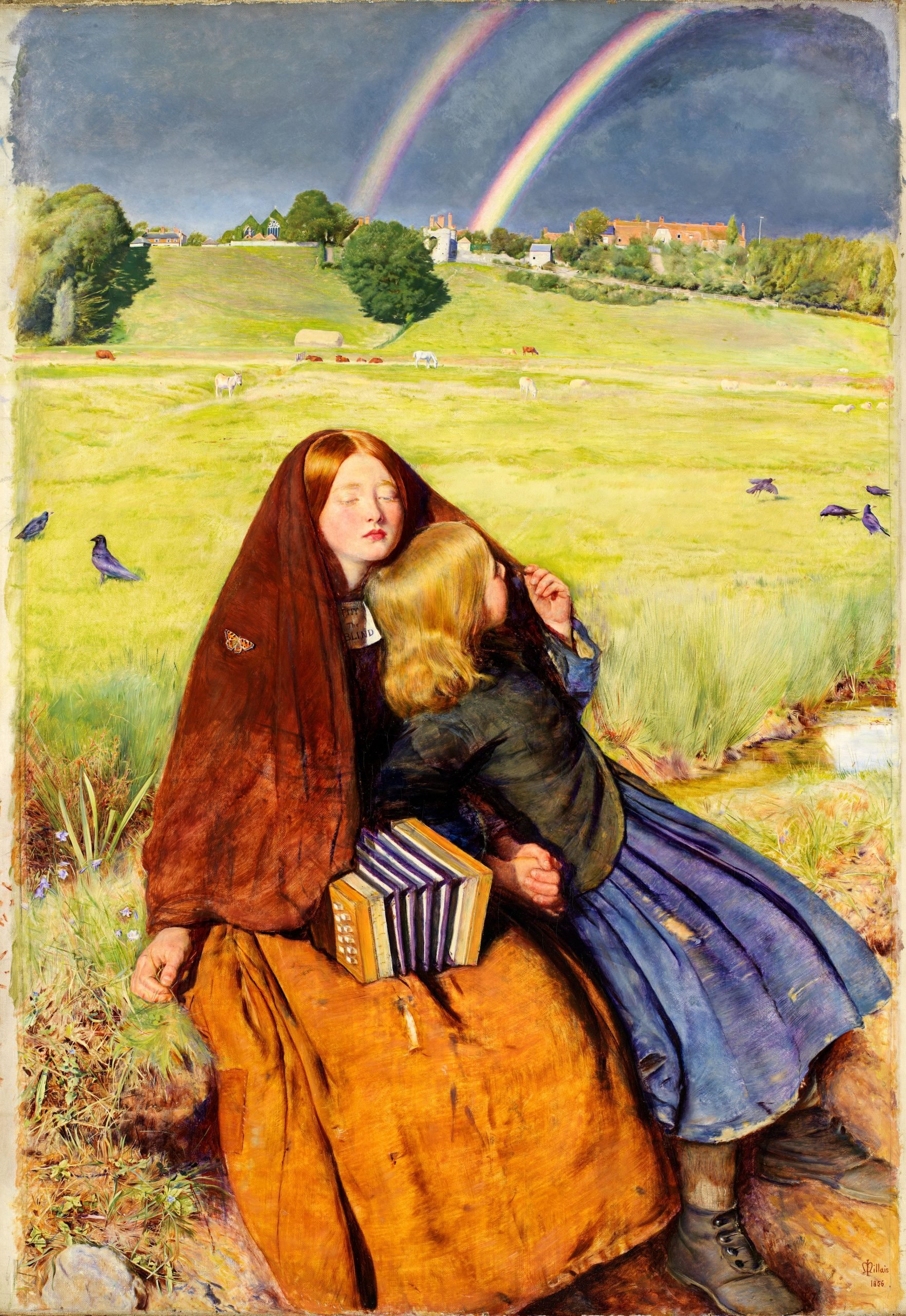
Pre-Raphaelite artist John Everett Millais’ painting The Blind Girl (1854–56) shows two girls sitting in a bright green meadow with a double rainbow in the background. While the younger girl stares into the distance, the older one has her eyes closed. On a sign around her neck, partially obscured by her shawl, appear the words “Pity the Blind.”
The phrase accurately describes attitudes towards blindness in the 19th century, when unsighted people were thought incapable of living productive, fulfilling lives. If they weren’t treated with contempt or morbid curiosity, they were pitied for their inability to fully perceive the world’s beauty.
And yet, the subject of Millais’ The Blind Girl doesn’t look like she’s missing out. Although she is unable to see the stunning environment in which she finds herself, she can still rely on her other senses, including smell. To this end, Millais, an eminent artist of the set known as the Pre-Raphaelites, included numerous objects that his contemporaries would have associated with an appealing scent, from the sunlit grass to the approaching storm clouds, and even the rainbows, which the average Victorian believed smelled of a spring field.
The Blind Girl is one of just one of the olfactory-focused paintings featured in “Scent & the Art of the Pre-Raphaelites,” an exhibition opening next month at the University of Birmingham’s Barber Institute of Fine Arts. The show is curated by Christina Bradstreet, art historian and author of the 2022 volume Scented Visions: Smell in Art, 1850-1914, and the paintings are accompanied by custom-made perfumes, diffused using AirParfum technology, that allow visitors to smell the complex scents the images evoke.
John Frederick Lewis, Lilium Auratum (1871). Photo: Barber Institute of Fine Arts.
The Pre-Raphaelite movement emerged in 1848 when British painters like Millais and Dante Rossetti broke with the Royal Academy’s enduring and, in their view, creatively stifling obsession with Raphael and the art of the Italian Renaissance. While their own work was no less concerned with supernatural beauty, the Pre-Raphaelites traded the earlier artist’s idealism in favor of something more materialistic, corporeal, and sensual.
As Bradstreet points out in Scented Visions, aroma played a key role in Pre-Raphaelite paintings, packed as they are with flowers and incense burners. If Renaissance artists like Raphael wanted to get their viewers to think about what they saw, the Pre-Raphaelites strove to produce more synesthetic responses, using images to evoke sound, smell, and touch.
The exhibition puts Bradstreet’s research into practice. For example, the perfume accompanying Simeon Solomon’s watercolor painting A Saint of the Eastern Church (1867–68), which shows a haloed man in a traditional Mass tunicle holding a sprig of myrtle and incense burner, smells—you guessed it—of myrtle, as well as dark amber wood.
Simeon Solomon, A Saint of the Eastern Church (1867-1868). Photo: Barber Institute of Fine Arts.
Evelyn de Morgan’s Medea (1889), meanwhile, shows a beautiful, seductive woman in a red dress inside a squeaky-clean marble cathedral, holding a potion that produces violet fumes. This work engages the Victorian notion that alluring scent was linked to moral and spiritual decadence. This conviction, which had been around since the early Middle Ages, gained traction during the 19th century as pushback against the Pre-Raphaelites’ revolutionary style mounted.
Thus, “Scent & the Art of the Pre-Raphaelites” not only recreates the fragrances associated with these paintings, but also investigates the role scent played in Victorian society.
“Pre-Raphaelite and Victorian Aesthetic paintings are so often described as ‘multi-sensory,’ but smell and its significance has been overlooked, despite being ‘under our noses’ all along,” Bradstreet said in a statement. “Many 19th and early 20th-century ideas about smell and smelling, such as the belief that smell is disease or that rainbows emanate the sweet scent of fresh, wet meadows after a rainstorm, seem outlandish today. Yet this contextual information lends a new and vital perspective for understanding some of the most iconic Victorian paintings.”
“Scent & the Art of the Pre-Raphaelites” will be on view at the Barber Institute of Fine Arts at the University of Birmingham, October 11, 2024 through January 26, 2025.